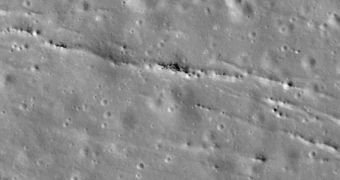The latest images sent back by the NASA Lunar Reconnaissance Orbiter (LRO) reveal interesting fissures on the bottom of the Aitken Crater, on the lunar surface. The landscape feature is located at 16.8°S, 173.4°E, for those of you who want to investigate it for yourselves.
The crater itself is rather large, featuring a diameter of about 135 kilometers (roughly 84 miles). Its floor was image using the narrow-angle cameras (NAC) on the LRO Camera (LROC) instrument.
Experts were surprised to discover a series of parallel linear fissures about 3.5 kilometers (2.14 miles) west of the crater's ridge, all of which were oriented along a NW-to-SE direction. Long pit-chains accompany the fissures, as they cross the terrain.
These pit-chains may be the result of material from the surface falling into large hollows underneath the ground. Some of these features appear to be very young.

 14 DAY TRIAL //
14 DAY TRIAL //